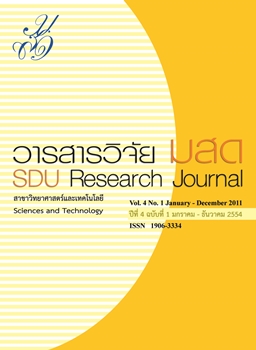การจัดการมลพิษทางเสียงเพื่อการจัดการสิ่งแวดล้อมอย่างยั่งยืนด้วยเทคโนโลยีสะอาด ในกระบวนการผลิตข้อต่อท่อประปาเหล็ก: กรณีศึกษาโรงงานบีสไพพ์ ฟิตติ้ง อินดัสตรี จำกัด
Keywords:
มลพิษทางเสียง, เทคโนโลยีสะอาด, Noise pollution, Clean technologyAbstract
บทคัดย่อ
การจัดการมลพิษทางเสียงเพื่อการจัดการสิ่งแวดล้อมอย่างยั่งยืนด้วยเทคโนโลยีสะอาด ในกระบวนการผลิตข้อต่อท่อประปาเหล็ก กรณีศึกษาโรงงานบีสไพพ์ ฟิตติ้ง อินดัสตรี จำกัด จังหวัดสมุทรสาคร มีวัตถุประสงค์เพื่อศึกษาระดับเสียงในเวลาปฏิบัติงานของโรงงานอุตสาหกรรมผลิตข้อต่อเหล็ก และสร้างแผนที่แนวเส้นเสียงที่เกิดขึ้น เพื่อจัดทำแนวทางแก้ไขปัญหามลพิษทางเสียงภายในโรงงาน โดยได้เก็บตัวอย่างระหว่างเดือนมีนาคม - เดือนกรกฎาคมพ.ศ. 2552 ตามแผนกการทำงานและตามการผลิตชิ้นงานที่กำหนดของโรงงาน โดยมีทั้งหมด 12 แผนก 15 จุดตัวอย่างพบว่าระดับเสียงเฉลี่ย (LAeq8) อยู่ในช่วง 81.0 - 98.1 เดซิเบล (A) และระดับเสียงสูงสุด (Lmax) อยู่ในช่วง 96.2 - 120.1เดซิเบล (A) บริเวณจุดตรวจวัดที่มีระดับเสียงเฉลี่ย (LAeq8) ต่ำสุด คือ แผนกเตาอบ (จุด 10) มีระดับเสียงอยู่ที่ 81.0เดซิเบล (A) ส่วนบริเวณที่มีระดับเสียงเฉลี่ย (LAeq8) สูงสุด คือ แผนกเจียรนัย (จุด 7E) มีระดับเสียง อยู่ที่ 98.1 เดซิเบล(A) และยังเป็นบริเวณที่มีค่าระดับเสียง Lmax สูงสุดด้วย ซึ่งมีระดับเสียงอยู่ที่ 120.1 เดซิเบล (A) เมื่อนำมาเปรียบเทียบกับมาตรฐานของประกาศกระทรวงอุตสาหกรรม เรื่องมาตรการคุ้มครองความปลอดภัยในการประกอบกิจการโรงงานเกี่ยวกับสภาวะแวดล้อมในการทำงาน หมวด 3 เสียง (พ.ศ. 2546) พบว่า ระดับเสียงมีค่าเกินมาตรฐานจำนวน 11 จุดคิดเป็นร้อยละ 73.33 ของจุดเก็บตัวอย่างทั้งหมด และไม่เกินค่ามาตรฐานจำนวน 4 จุด คิดเป็นร้อยละ 26.67 ของจุดเก็บตัวอย่างทั้งหมด การเก็บตัวอย่างเสียงเพื่อสร้างแผนที่แนวเส้นเสียง ทำได้โดยวิธีการตีกริดขนาด 2×2 เมตร ภายในพื้นที่ปฏิบัติงานของโรงงาน โดยมีจุดตรวจวัดทั้งหมด 610 จุด แล้วนำมาสร้างแผนที่แนวเส้นเสียงด้วยโปรแกรมSURFER (version 8) พบว่า ระดับเสียงสูงสุดมีค่า 104 เดซิเบล (A) ซึ่งเป็นบริเวณแผนกเคาะเลือก และระดับเสียงต่ำสุด คือ 75.7 เดซิเบล (A) อยู่บริเวณแผนกเตาหลอมไฟฟ้า ดังนั้นเพื่อความปลอดภัยและประสิทธิภาพในการทำงานจึงควรที่จะให้พนักงานสวมอุปกรณ์ป้องกันเสียงในพื้นที่ที่มีระดับเสียงสูงและมีการตรวจสอบและบำรุงเครื่องจักรทุกชิ้นให้อยู่ในสภาพดี เพื่อที่จะได้เป็นการลดระดับเสียงที่เกิดขึ้นภายในโรงงานผลิตข้อต่อเหล็กอย่างยั่งยืน
คำสำคัญ: มลพิษทางเสียง; เทคโนโลยีสะอาด
Abstract
This research aimed to study the noise level during the process of joint fittings production and toprovide the noise contour lines for the sustainable management of noise pollution of “Bis Pipe Fitting Industry”company. The noise from totally 15 stations (12 divisions) was measured during March - June 2008. It wasfound that the average noise level (LAeq8) was in the range of 81.0 - 98.1 dB (A) and the maximum noise level(Lmax) was in the range of 96.2 - 120.1 dB (A). The lowest noise level was found at station 10, accounted for81.0 dB (A) whereas the highest noise level was found at station 7E, accounted for 98.1 dB (A). The maximumnoise level accounted for 120.1 dB (A) was also found at this station. The noise level from 11 stations (73.33%)of all 15 stations exceeded the standard stated in the Occupational Health and Safety Act issued by the Ministryof Interior. In order to provide the noise contour lines of the working units, the noise level in 610 stations werecollected within 2 × 2 meter-gridline. Then, they were analyzed by SURFER software (version 8) in order todraw contour line model. Based on the model, the maximum noise level was 104.0 dB (A) whereas theminimum noise level was 75.7 dB (A) This can be concluded from the contour line model that the noise in somedivisions posed the risk to the working staff. Therefore, the workers in all divisions or in high risky areas shouldwear the protecting devices for their safety and their work efficacy. In addition, all the machines should be keptwell maintained for the sustainable management of noise pollution in the factory.
Keywords: Noise pollution; Clean technology






